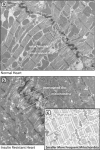Mitochondrial biogenesis in the metabolic syndrome and cardiovascular disease
- PMID: 20725711
- PMCID: PMC4319704
- DOI: 10.1007/s00109-010-0663-9
Mitochondrial biogenesis in the metabolic syndrome and cardiovascular disease
Abstract
The metabolic syndrome is a constellation of metabolic disorders including obesity, hypertension, and insulin resistance, components which are risk factors for the development of diabetes, hypertension, cardiovascular, and renal disease. Pathophysiological abnormalities that contribute to the development of the metabolic syndrome include impaired mitochondrial oxidative phosphorylation and mitochondrial biogenesis, dampened insulin metabolic signaling, endothelial dysfunction, and associated myocardial functional abnormalities. Recent evidence suggests that impaired myocardial mitochondrial biogenesis, fatty acid metabolism, and antioxidant defense mechanisms lead to diminished cardiac substrate flexibility, decreased cardiac energetic efficiency, and diastolic dysfunction. In addition, enhanced activation of the renin-angiotensin-aldosterone system and associated increases in oxidative stress can lead to mitochondrial apoptosis and degradation, altered bioenergetics, and accumulation of lipids in the heart. In addition to impairments in metabolic signaling and oxidative stress, genetic and environmental factors, aging, and hyperglycemia all contribute to reduced mitochondrial biogenesis and mitochondrial dysfunction. These mitochondrial abnormalities can predispose a metabolic cardiomyopathy characterized by diastolic dysfunction. Mitochondrial dysfunction and resulting lipid accumulation in skeletal muscle, liver, and pancreas also impede insulin metabolic signaling and glucose metabolism, ultimately leading to a further increase in mitochondrial dysfunction. Interventions to improve mitochondrial function have been shown to correct insulin metabolic signaling and other metabolic and cardiovascular abnormalities. This review explores mechanisms of mitochondrial dysfunction with a focus on impaired oxidative phosphorylation and mitochondrial biogenesis in the pathophysiology of metabolic heart disease.
Conflict of interest statement
Figures



Similar articles
-
Cardiac dysfunction and oxidative stress in the metabolic syndrome: an update on antioxidant therapies.Curr Pharm Des. 2013;19(27):4806-17. doi: 10.2174/1381612811319270003. Curr Pharm Des. 2013. PMID: 23323621 Free PMC article. Review.
-
Mitochondrial biogenesis: pharmacological approaches.Curr Pharm Des. 2014;20(35):5507-9. doi: 10.2174/138161282035140911142118. Curr Pharm Des. 2014. PMID: 24606795
-
Renin-angiotensin-aldosterone system and oxidative stress in cardiovascular insulin resistance.Am J Physiol Heart Circ Physiol. 2007 Oct;293(4):H2009-23. doi: 10.1152/ajpheart.00522.2007. Epub 2007 Jun 22. Am J Physiol Heart Circ Physiol. 2007. PMID: 17586614 Review.
-
Role of AMP-activated protein kinase on cardio-metabolic abnormalities in the development of diabetic cardiomyopathy: A molecular landscape.Eur J Pharmacol. 2020 Dec 5;888:173376. doi: 10.1016/j.ejphar.2020.173376. Epub 2020 Aug 15. Eur J Pharmacol. 2020. PMID: 32810493 Review.
-
Defective mitochondrial biogenesis: a hallmark of the high cardiovascular risk in the metabolic syndrome?Circ Res. 2007 Mar 30;100(6):795-806. doi: 10.1161/01.RES.0000259591.97107.6c. Circ Res. 2007. PMID: 17395885 Review.
Cited by
-
Does Transient Receptor Potential Vanilloid Type 1 Alleviate or Aggravate Pathological Myocardial Hypertrophy?Front Pharmacol. 2021 May 10;12:681286. doi: 10.3389/fphar.2021.681286. eCollection 2021. Front Pharmacol. 2021. PMID: 34040539 Free PMC article. Review.
-
Cardiac dysfunction and oxidative stress in the metabolic syndrome: an update on antioxidant therapies.Curr Pharm Des. 2013;19(27):4806-17. doi: 10.2174/1381612811319270003. Curr Pharm Des. 2013. PMID: 23323621 Free PMC article. Review.
-
A gestational high protein diet affects the abundance of muscle transcripts related to cell cycle regulation throughout development in porcine progeny.PLoS One. 2012;7(4):e34519. doi: 10.1371/journal.pone.0034519. Epub 2012 Apr 9. PLoS One. 2012. PMID: 22496824 Free PMC article.
-
Inflammatory cause of metabolic syndrome via brain stress and NF-κB.Aging (Albany NY). 2012 Feb;4(2):98-115. doi: 10.18632/aging.100431. Aging (Albany NY). 2012. PMID: 22328600 Free PMC article. Review.
-
Metformin for Cardiovascular Protection, Inflammatory Bowel Disease, Osteoporosis, Periodontitis, Polycystic Ovarian Syndrome, Neurodegeneration, Cancer, Inflammation and Senescence: What Is Next?ACS Pharmacol Transl Sci. 2021 Nov 1;4(6):1747-1770. doi: 10.1021/acsptsci.1c00167. eCollection 2021 Dec 10. ACS Pharmacol Transl Sci. 2021. PMID: 34927008 Free PMC article. Review.
References
-
- Sullivan PW, Ghushchyan V, Wyatt HR, Wu EQ, Hill JO. Impact of cardiometabolic risk factor clusters on health-related quality of life in the U.S. Obesity (Silver Spring) 2007;15:511–521. - PubMed
-
- Cannon CP, Kumar A. Treatment of overweight and obesity: lifestyle, pharmacologic, and surgical options. Clin Cornerstone. 2009;9:55–68. discussion 69–71. - PubMed
-
- Sowers JR. Metabolic risk factors and renal disease. Kidney Int. 2007;71:719–720. - PubMed
-
- Smith SC., Jr Multiple risk factors for cardiovascular disease and diabetes mellitus. Am J Med. 2007;120:S3–S11. - PubMed
Publication types
MeSH terms
Substances
Grants and funding
LinkOut - more resources
Full Text Sources
Other Literature Sources
Medical

